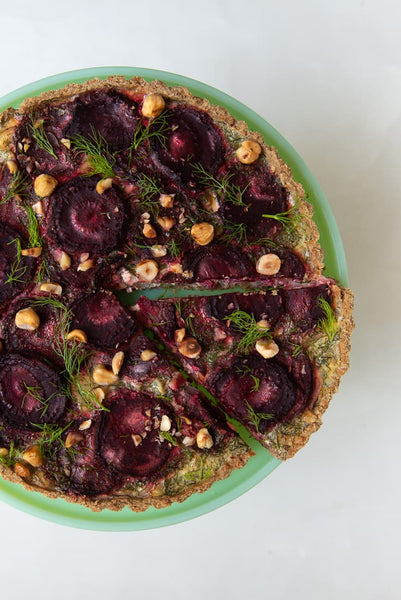
Liquorice, Beetroot, Fennel, Hazelnut And Rye Tart
By Victoria Glass
-
Intermediate

Liquorice powder might not be an obvious contender for inclusion in a savoury dish, but this Nordic-inspired tart will convert anyone in no time. The aniseed headiness of liquorice, fennel and dill balance the earthiness of the beetroot and hazelnuts in this surprising and moreish tart.
The colours are striking enough to serve as an impressive make-ahead lunch when you have guests coming and can be eaten warm out of the oven or cold. If it’s been stored in the fridge, take it out one hour before serving to come up to room temperature.
Ingredients for the pastry Serves: 6
- 100g fine plain wholemeal flour
- 100g rye flour
- A good pinch of fine sea salt
- 110g cold, unsalted butter
- 1 medium egg, divided into yolk and white
- 1-2 tbsp cold water
Ingredients for the filling
- 1 fennel, sliced
- 1 onion, sliced into half moons
- 20g unsalted butter
- 300g ready to eat cooked beetroot
- 2 tsp liquorice powder
- 2 medium eggs
- 125g natural yoghurt
- 75ml double cream
- 20g fresh dill
- 50g blanched hazelnuts
- Salt and pepper
Method for liquorice, beetroot, fennel, hazelnut and rye tart
- Put the fine plain wholemeal flour, rye flour, and a good pinch of fine sea salt into a food processor and pulse to combine. Add the cold, unsalted butter, cut into cubes, and pulse again until the mixture looks like fine breadcrumbs. Add an egg yolk, saving the white for later, and pulse to combine. Gradually add 1-2 tbsp cold water and keep pulsing until a ball of dough has formed. This whole process can also be done by hand. Tip the dough out onto a sheet of clingfilm, wrap and refrigerate for half an hour.
- Slice the fennel and slice an onion into half-moons, and fry them in unsalted butter until soft and caramelised. You can add a splash of water if the vegetables start to stick before they have finished cooking. Season generously and set aside.
- Preheat the oven to 190°C (170°C fan). Roll out the pastry on a sheet of baking parchment (this should limit the need for any extra flour for dusting) until approx. 3mm thick. This pastry tears easily but can be patched up without issue. Lift the sheet of pastry on the baking parchment and upturn it over a 20cm tart tin/loose-bottomed sandwich cake tin and use the paper to help press the pastry into the tin before gently peeling off the paper. Patch up any bits of pastry; it is fine for this tart to be rustic.
- Line the pastry with baking parchment (it is fine to use the same piece as long as the used side is facing down) and tip in baking beans or uncooked rice. Blind bake the pastry for 15 minutes, then remove the baking beans and paper and return to the oven for a further 10 minutes.
- Remove the tart from the oven again and brush the pastry with some beaten egg white and return to the oven for a final 5 minutes to dry out.
- While the pastry case is baking, prepare the filling. Slice ready to eat cooked beetroot (or you can peel and boil fresh) and toss it in liquorice powder and set aside.
- In a jug, whisk together the eggs, natural yoghurt, and double cream. Generously season with salt and pepper. Finely chop dill and stir most of it into the egg mixture, reserving a little to scatter over the top after baking.
- Toast the hazelnuts in a dry pan until golden, then roughly chop. Once the tart case has baked, tip in the fennel and onion to make an even layer at the bottom and scatter over two-thirds of the chopped nuts. Next add the least attractive beetroot slices and pour over the dill custard mixture. Arrange the remaining beetroot slice over the top and scatter over the rest of the hazelnuts.
- Return the tart to the oven for 30-35 minutes, or until set and lightly golden. Leave the tart to cool on a wire rack for 15 minutes, before taking it out of its tin.
- Scatter the top with the reserved chopped dill and serve warm or cold.


About the author
Victoria Glass is a London based writer and recipe developer. She has written six cookbooks, including Too Good To Waste and has contributed to various print and online media including The Sunday Times, Great British Chefs, Delicious. Magazine, Women’s Health and The Evening Standard. She has been featured regularly on regional BBC Radio as a food and drink expert and was Food Writer in Residence at the Roald Dahl Museum and Story Centre. Victoria once cooked her way through the alphabet in a year for a project called Alphabet Soup, so she certainly knows her artichokes from her elbow.


